Gates of the Temple Mount
The Temple Mount, located in Jerusalem, can be accessed through twelve gates, and contains a further six sealed gates. This list does not include the Gates of the Old City of Jerusalem around the external walls.
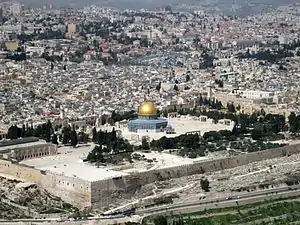
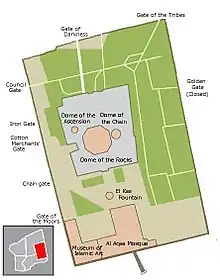
Open gates
The following is an anti-clockwise list of gates which open onto the Temple Mount. Currently eleven gates are open to the Muslim public. Non-Muslims are permitted to enter only through the Mughrabi (or Morocco, or Moors) gate.[1]
Gate of the Tribes
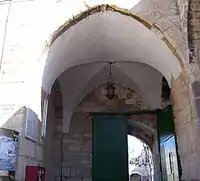
The Gate of the Tribes (Arabic: باب الأسباط, Hebrew: שער השבטים ) is located at the north-eastern corner of the Temple Mount. Its name refers to the 12 tribes of Israelites who left Egypt and came to the Holy Land to find the Promised Land.[2] Bab al- Asbät is located to the east of the short northern side of the al-Aqsa enclave. Behind the gate, there is also a road as the Lions' Gate in the old city (also known as St Stephen's Gate).
Asbät gate is one of the important ancient gates and the gate names had been given by Ibn al Fakih and Ibn Abd' Rabbih two earliest authorities.[3] The Asbät gate was first built by the Mamluk Ruler Bybars.[4]Later, the door was renewed by Sultan Süleyman I during the Ottoman period. According to a legend, Sultan Suleyman I, who had a bad dream, is claimed to have started to renew the walls of Jerusalem Beytulmakdis after this dream.[5]
The Asbät gate is located on the northern wall of the Haram al-Sharif and it is in the double gateway also, it is almost directly opposite Ahwab Mihrab Mariam.[6] The entrance to the gate is impressively decorated. There has the single opening of a semicircular arch with a distinctive 45-degree chamfer and segmental inner arch at the part of the gate that has reached the present time, also the masonry of the wall shows that there are two gates because 1.20 meters of the gate wall reaches to the west side.[7] According to Ratrout, the Early Muslim architecture of Bab al-Asbät and its dimensions coincide with those of Bab al-Hashmi. Bab al-Asbät is 2.81 meters in the width of the doorway, 3.30 meters in the width of the inner threshold of the doorway, and 4.30 meters in height of its arch.[8]
Gate of Remission
The Gate of Remission (Arabic: Bab al-Huttah) is located on the north side.
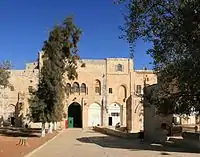
Gate of Darkness
The Gate of Darkness (Arabic: باب العتم ,Bab al-Atim) is one of the three gates located on the north side. It is traditionally known as Gate of al-Dawadariya (باب الدوادرية ). More recently it is also known as King Faisal Gate (باب الملك فيصل). It is located close to the al-Dawadariya School. The gate is four meters tall with an arched roof. At least a couple renovations are known, once circa 1213 during the reign of Ayyubid King Al-Moatham Sharf Ad-Din Issa and then circa 1930 by King Faisal of Saudi Arabia.[9]
Gate of Bani Ghanim
The Gate of Bani Ghanim (Arabic: Bab al-Ghawanima) is located on the north-western corner.
Gate of the Seraglio or Palace (closed)
A twelfth gate still open during Ottoman rule is now closed to the public: Bab as-Sarai (Gate of the Seraglio, or of the Palace); a small gate to the former residence of the Pasha of Jerusalem; in the northern part of the western wall, between the Bani Ghanim and Council gates.
Council Gate
The Council Gate (Arabic: Bab al-Majlis), also known as the Inspector's Gate (Arabic: Bab an-Nazir or Nadhir), is located on the northern side of the western Temple Mount wall.
Iron Gate
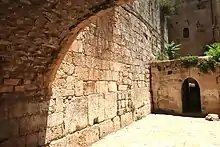
The Iron Gate (Arabic: Bab al-Hadid, Hebrew: Shaar Barzel) is located on the western side, at the end of Bab al-Hadid Street, being within the Muslim Quarter, and where, before entering, one gains access to an exposed and contiguous section of the ancient wall of the Temple Mount, known locally as the Little Western Wall.[10]
Cotton Merchants' Gate
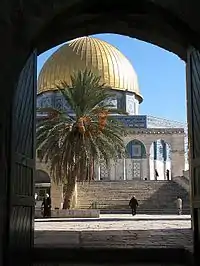
The Cotton Merchants' Gate (Arabic: باب القطانين ,Bab al-Qattanin Hebrew: שער מוכרי הכותנה) is one of the most beautiful gates that leads onto the Temple Mount. It was built by the ruler of Damascus, Tankiz, during the reign of Mamluk Sultan ibn Qalawun, as marked by an inscription over the door.[11] Since this site is the closest a person can get to the Foundation Stone without setting foot on the mount itself, the gate was a popular place of prayer for Jews during the 19th century.
Ablution Gate

The Ablution Gate (Arabic: Bab al-Matharah باب المطهرة) is located on the western flank.
Tranquility Gate
The Tranquility Gate (Arabic: Bab as-Salam), also Gate of the Dwelling (Bab as-Sakina), is located in the central part of the western wall.
Chain Gate
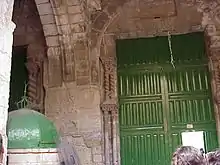
The Chain Gate (Arabic: باب السلسلة, Bab as-Silsileh; Hebrew: Shaar HaShalshelet) is located on the western flank. It may have been the location of the Kipunos (Coponius) Gate, which existed during the Second Temple period.
Moors Gate
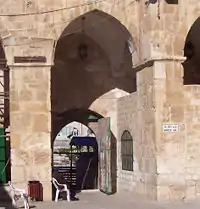
The Morocco Gate, known in Israel as Mughrabi Gate,[12][13] (Arabic: باب المغاربة, Bab al-Magharbeh; Hebrew: Shaar HaMughrabim), is located on the western flank, directly over the Herodian-period gate known as Barclay's Gate. Over the years, the ground level outside Barclay's Gate rose by many meters above its threshold and Barclay's Gate was finally walled up in the 10th century. At some stage, probably in the 12th century and maybe even later, a new gate called Bab al-Magharbeh was installed in the Western Wall above Barclay's Gate, at the level of the Temple Mount esplanade. It was named after the residents of the adjacent neighborhood, who had come to Jerusalem from the Maghreb in the days of Saladin. This gate is open to this day and has been since 1967 the only entrance to the Temple Mount accessible to non-Muslims.[12][13]
The gate, specifically the excavation of the historic ramp leading up to it, has been a point of contention between Israelis and Arab Muslims.[14] In February 2004, a wall which supported the 800-year-old ramp jutting out from the Western Wall and leading up to the Gate of the Moors, partially collapsed. Israeli authorities believed a recent earthquake and snowfall may have been responsible, while Hamas and Muslim officials blamed the collapse on Israelis working in the area.[15][16] In 2007, the Israel Antiquities Authority (IAA) built a temporary wooden pedestrian bridge to the Gate of the Moors. No agreement could be reached over a more permanent structure.
The damaged ramp, situated beneath the bridge and not connected to it, consists of an accumulation of archaeological layers which have been excavated by the IAA, who removed surface material and made visible several ruined structures. This was done in contravention to the action plan initially submitted by the IAA to the UNESCO.
In 2013, an archaeological excavation was conducted at the Mughrabi Gate by Hayim-Her Barbe, Roie Greenvald, and Yevgeni Kagan, on behalf of the Israel Antiquities Authority (IAA).[17]
Sealed gates
The wall surrounding the Temple Mount contains six sealed gates. Here is a counter clockwise list:
Golden Gate

The Golden Gate (Arabic: باب الرحمة, lit. 'Bab al-Rahema', "Mercy Gate"; Hebrew: Sha'ar Harachamim, "Gate of Mercy"), located on the eastern wall of the Temple Mount, was probably built in the 520s CE, as part of Justinian I's building program in Jerusalem, on top of the ruins of an earlier gate in the wall. An alternate theory holds that it was built in the later part of the 7th century by Byzantine artisans employed by the Umayyad khalifs. It has two vaulted halls which lead to the Door of Mercy, Bab al-Rahma, and the Door of Repentance, Bab al-Taubah. Closed by the Muslims in 810, reopened in 1102 by the Crusaders, it was walled up by Saladin after regaining Jerusalem in 1187. Suleiman the Magnificent rebuilt it together with the city walls, but walled it up in 1541, and it stayed that way until today.[18] The 1st-century historian, Josephus, who mentions the "eastern gate" in his Antiquities, makes note of the fact that this gate was considered within the far northeastern extremity of the inner sacred court.[19] According to the Mishnah, there was formerly a causeway which led out of the Temple Mount eastward over the Kidron Valley, extending as far as the Mount of Olives.[20] Rabbi Eliezer, dissenting, says that it was not a causeway, but rather marble pillars over which cedar boards had been laid, used by the High Priest and his entourage.[21] This gate was not used by the masses to enter the Temple Mount, but reserved only for the High Priest and all those that aided him when taking out the Red Heifer or the scapegoat on the Day of Atonement.
Dutch archaeologist Leen Ritmeyer, who explored the gate in the 1970s, reached the conclusion that the two monolithic massive gateposts seen on the inside of the gate belong to an old structure of the gate, thought to be the Shushan Gate (mentioned in Mishnah Middot 1:3 as being the only gate in the Eastern Wall), and that it dates from the First Temple period.[22]
Warren's Gate
Barclay's Gate
Barclay's Gate lies under the Moroccans' Gate (Moor's Gate) and is one of the four Temple Mount's original gates on its western side. Its Arabic name is Bab an-Nabi, "Gate of the Prophet [Muhammad]" (see Le Strange, Palestine Under the Moslems p. 189) - not to be confused with the Triple Gate, which has the same Arabic name. Barclay's Gate is named after James Turner Barclay who was a Christian missionary in Jerusalem in the mid-19th century, and who discovered the main structure of the gate buried underground within the Temple Mount, in 1852.[23] Several researchers identified it as one of the Second Temple period gates, possibly the Coponius Gate, which is mentioned in Jewish and Christian sources of the period. The gate was blocked with stones at the end of the 10th century and the internal gate room was transformed into a mosque dedicated to Buraq. Today the room is closed and entrance to it is prohibited without the approval of the Waqf.[24]
After the Six-Day War, the Israel Religious Affairs Ministry and Prof. Benjamin Mazar, who was at the time conducting the dig outside the southern wall of the Temple Mount, planned to uncover this gate, but they were prevented from doing so by both Jewish and Muslim religious leaders.[25]
Huldah Gates
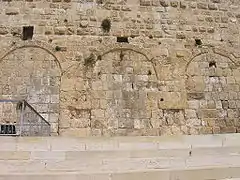
The Huldah Gates comprise two sets of bricked-up gates in the southern wall of the Temple Mount.
The fact that the original entrance gateways still exist reflects an ancient promise cited in a work of rabbinic literature, Shir ha-Shirim Rabbah: "The Kohen Gate and the Huldah Gate were never destroyed and God will renew them". The 1st-century historian, Josephus, mentions these gates in his Antiquities: "...the fourth front of the temple [mount], which was southward, had indeed itself gates in its middle."[26]
Double Gate
Of the Huldah Gates, the left set is a double-arched gate, known as the Double Gate (Arabic: Bab ath-Thulathe). It is partially blocked from vision by a crusader tower and only part of the right gate can be seen. The only original part of the gate still visible is the lintel and even this is no longer in its original position. When first laid it was 11 metres above the doorstep.
Triple Gate
The set on the right is a triple-arched gate, known as the Triple Gate (Arabic: Bab an-Nabi, "Gate of the Prophet [Muhammad]") - not to be confused with Barclay's Gate, which has the same Arabic name. Each of the gates once led into a passageway stretching underneath the esplanade of the Mount, and then to steps leading up to the esplanade itself.
Single Gate
The Single Gate is located along the southern wall. It once led to the underground area of the Temple Mount known as Solomon's Stables.
See also
References
| Wikimedia Commons has media related to Gates of the Temple Mount. |
- Elaine McArdle, "How to visit Temple Mount as a tourist: Old City, Jerusalem, Israel," The Whole World is a Playground, 1 January 2015
- Ugurluel, Talha (2020). Arzin Kapisi Kudus. Timas Tarih. p. 33. ISBN 978-605-08-2425-4.
- Strange, Guy Le (1890). Palestine Under the Moslem: A description of Syria and Holy Land. OCOMMITTEE F THE PALESTINE EXPLORATION FUND. p. 185.
- Yilmaz, Hayrunisa (22 December 2019). "Kudüs'teki Memlûk Türk Devleti Armaları ('Renk'ler)". Belleten. 83 (298): 917.
- "4/5/2020".
- AL-RATROUT, HAITHEM FATHI (2004). PHYSICAL DEVELOPMENT OF Al-AQSA MOSQUE, in: The Architectural Development of Al-Aqsa Mosque in Islamic Jerusalem in the Early Islamic Period. Al-Maktum Institute Academic Press. p. 307.
- AL-RATROUT, HAITHEM FATHI (2004). PHYSICAL DEVELOPMENT OF Al-AQSA MOSQUE, in: The Architectural Development of Al-Aqsa Mosque in Islamic Jerusalem in the Early Islamic Period: Sacred Architecture in the Shape of "The Holy.". Al-Maktum Institute Academic Press. p. 307.
- AL-RATROUT, HAITHEM FATHI (2004). PHYSICAL DEVELOPMENT OF Al-AQSA MOSQUE, in: The Architectural Development of Al-Aqsa Mosque in Islamic Jerusalem in the Early Islamic Period: Sacred Architecture in the Shape of "The Holy.". Al-Maktum Institute Academic Press. p. 314.
- "Gate of Darkness". Madain Project. Retrieved 27 April 2019.
- Nine unknown sites in the Old City of Jerusalem, Oren Cahanovitc: The Small Wailing Wall
- Eliyahu Wager (1988). Illustrated guide to Jerusalem. Jerusalem: The Jerusalem Publishing House. p. 35.
- "Tourism Min. plan to widen Jewish access to Temple Mount angers Palestinians". Haaretz. 7 October 2014. Retrieved 5 November 2014.
- "Israel issues tender for new settlement units". Al Jazeera. 18 December 2011. Retrieved 5 November 2014.
- Marshall J. Breger; Yitzhak Reiter; Leonard Hammer (19 June 2013). Sacred Space in Israel and Palestine: Religion and Politics. Routledge. pp. 251, 266. ISBN 978-1-136-49034-7.
- BBC NEWS. Warning over Jerusalem holy site
- Jerusalem wall collapse sparks Jewish-Muslim row
- Israel Antiquities Authority, Excavators and Excavations Permit for Year 2013, Survey Permit # A-6697
- Dr. J. Randall Price, Rose Guide To The Temple. Rose Publishing 2013, p. 135, ISBN 9781596364684
- Josephus, Antiquities 15.424
- Mishnah (Parah 3:6; Middot 1:3)
- Tosefta Parah 3:7
- Ritmeyer, L. (11 March 2019). "The Golden Gate of the Temple Mount in Jerusalem - The interior of the Golden Gate in the 1970's". History, Image Library, Jerusalem, News, Temple Mount. Retrieved 20 October 2020.
- Josephus, Antiquities (xv, 410 [15.11.5]), Loeb Classical Library, ed. H.St.J. Thackeray, Heinemann: London 1926
- Baruch, Yuval. "The Mughrabi Gate Access - The Real Story". Israel Antiquities Authority. Retrieved 10 July 2007.
- Shragai, Nadav (12 February 2007). "The gate of the Jews". Haaretz. Retrieved 10 July 2007.
- Josephus, Antiquities 15.410
- Charles Wilson (1879). Quarterly Statement for 1879. London: Palestine Exploration Fund. Retrieved 24 September 2015.
Over the doorway of the postern there is a sort of lintel, but there are no regular jambs, and the whole has more the appearance of a hole broken through the masonry and afterwards roughly filled up than that of a postern in a city wall ; still it probably marks the site of Mejr-ed-Din's Gate of Burak.